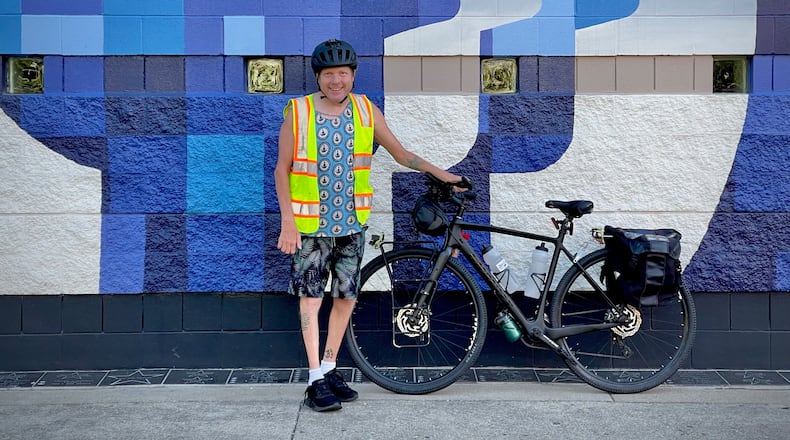According to a press release, CMT “causes muscle weakness, impaired balance, difficulty walking, and progressive nerve degeneration. Many live for years without an accurate diagnosis or appropriate care.”
McElfresh is raising awareness of CMT with his ride, while also fundraising for CMT research and treatments. The disease, named after the three doctors who discovered it, started affecting him when he was 10 years old. He was originally diagnosed with Dejerine-Sottas disease, which is similar to CMT. It wasn’t until he was 41 and underwent genetic testing that he found out he had CMT.
“It affects my hands and my feet,” McElfresh said. “My gait is very different than the way that people walk, and then also my hands are pretty well shot. I used to be able to play the guitar, play the piano, and now I can no longer even open a Ziploc bag.”
How can McElfresh ride a bike?
“When I was a teenager,” he said, “they did three surgeries on my feet, and they pretty much locked my feet in place so they didn’t continue to get worse. I’m able to ride a bicycle because my feet are essentially shaped like a normal person’s feet.”
McElfresh also can still walk thanks to those surgeries as he explained on the CMTA website.
“I can’t wiggle my toes, and one foot is an inch shorter than the other,” he wrote. “My feet are scarred, with long puckered white lines running over purple and blue skin and across my arches. Half erased long division problems are written on straight toes. My feet are forever locked in place now, cemented against the coming of age, but they’re mostly straight and flat. My toes reach the ground where I need them to, allowing me some semblance of balance.”
The muscles in McElfresh’s hands have atrophied. He constantly wants to grip things with his hands. That’s how he’s able to hold onto the handlebars.
McElfresh wants to raise money for kids who need the same foot surgeries he had when he was young. He timed his ride to arrive in Indianapolis for the CMTA Patient & Research Summit, which started Friday night.
McElfresh is featured in a PBS documentary, “Jeffrey’s Journey,” which screened Friday night and can be streamed on YouTube and ThinkTV.org. He will join a live question-and-answer session after the screening.
McElfresh has only recently started telling his story.
“I spent so many years as a disabled person attempting to be invisible,” he said, “that now trying to actually raise awareness and tell my story is a complete shift in my mindset.”
The documentary follows McElfresh on another bike ride. He spent 10 days cycling from Pittsburgh to Cincinnati along the Ohio River in August 2024 The opening scene of the film shows a close-up of McElfresh’s hands as he narrates.
“These hands are mine,” he said. “This disease is incredibly rare. And it’s not just my hands that are failing me. It’s genetic. And it’s progressive. So I haven’t always had these struggles. Each year, walking becomes more difficult, but when I’m on two wheels, that is a different story. I’m an adventure cyclist. I’m on the road for days or even months at a time. It’s a way for me to learn about my world and myself.”
About the Author

